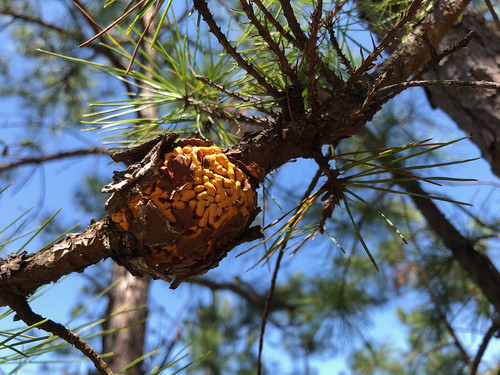Rust infection can weaken, kill Arkansas native pine trees
By Mary Hightower
U of A System Division of Agriculture
Fast facts:
- Fusiform rust spores travel miles in the wind
- Infection causes galls that from weak spots in the trunk
(270 words)
(Newsrooms: With downloadable images at https://flic.kr/p/24EK91w and https://flic.kr/p/25FP92j)
Download Word version
HOPE, Ark. – It’s that time of year where pines and other flowering plants are dusting the world with tons of yellow pollen, but if you see orange dust on a pine tree, that could be the sign of a damaging infection, said Jon Barry, extension forester with the University of Arkansas System Division of Agriculture.
“That orange dust may be spores of fusiform rust, a fungal disease that afflicts our native loblolly pine,” he said “Over time, the fungus produces galls on the pine trunk or branches. Fusiform rust can kill young trees, and the galls on the trunk may weaken the structure of the tree and may cause the tree to break at the gall during a storm.”

Once a tree is infected with fusiform rust there is no way to cure the tree.
“If you have a tree with a fusiform rust gall near your house, have the tree evaluated by an arborist or a forester to determine whether the tree is safe,” Barry said.
Fusiform rust fungus infects new needles and cones and spreads slowly into the tree.
“If the trees are more than 10 years old, removing the infected tree will do little to reduce the risk of additional trees being damaged by the infection,” he said. “The spores can be carried for miles by wind, so your pines will get a dose of the fungal spores. If the trees are more than 10 years old, infections that occur will usually be on the branches or upper crown where they are less likely to be a real problem.”
The Cooperative Extension Service has a fact sheet on fusiform rust that includes symptoms to help identify the disease: “Fusiform Rust in Arkansas, FSA7543”and may be downloaded here: https://www.uaex.uada.edu/publications/PDF/FSA-7543.pdf
For more information about forestry in Arkansas, visit www.uaex.uada.edu or contact your county extension office.
About the Division of Agriculture
The University of Arkansas System Division of Agriculture’s mission is to strengthen agriculture, communities, and families by connecting trusted research to the adoption of best practices. Through the Agricultural Experiment Station and the Cooperative Extension Service, the Division of Agriculture conducts research and extension work within the nation’s historic land grant education system.
The Division of Agriculture is one of 20 entities within the University of Arkansas System. It has offices in all 75 counties in Arkansas and faculty on five system campuses.
Pursuant to 7 CFR § 15.3, the University of Arkansas System Division of Agriculture offers all its Extension and Research programs and services (including employment) without regard to race, color, sex, national origin, religion, age, disability, marital or veteran status, genetic information, sexual preference, pregnancy or any other legally protected status, and is an equal opportunity institution.
# # #
Media Contact: Mary Hightower
Dir. of Communication Services
U of A System Division of Agriculture
Cooperative Extension Service
(501) 671-2126
mhightower@uada.edu